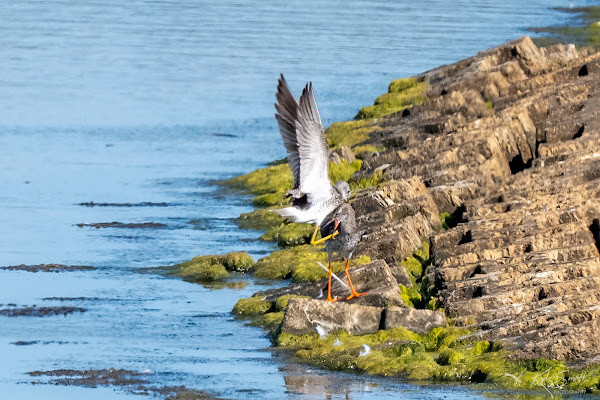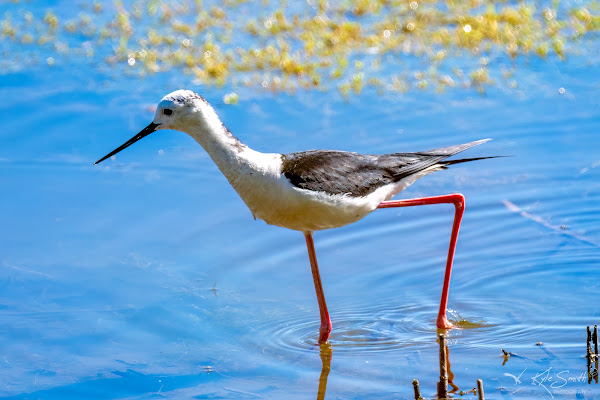We set off early on Saturday morning to see the white rumped sandpiper at Dorney Flash on the Buckinghamshire / Berkshire border. It was a clear run and we arrived through the common and encountered cows crossing the road at will - the flat common and spread out herd of cows was an unexpected and strange sight, especially with this road running through. We saw the flash off to our left and two birders already in residence, both standing with scopes and viewing the flash - we jumped out the car, grabbed our gear and set off across the common; a large traditional grassed common, roughly triangular, which is an SSSI and offers panoramic views of Windsor Castle 2½ miles to the east.
No sooner had we set off than ring-necked parakeets called, and a handful flew overhead. Although there are some resident in Banbury I haven't encountered them this year and so this was a year tick - now for the sandpiper. We reached the birders with only one remaining, the other having walked around the lake on our right. We were greeted with "I wouldn't get your hopes up". Sure enough, there was no sign of our target bird, nor the dunlin that it appeared to have been associating with. Scanning around we saw four little ringed plovers and had a great white egret rise from the reeds to our right. Little egret, lapwing and stock dove all showed, but not our bird - Ewan Urquhart arrived and we said hello, then Dylan Parry-Davies and his partner. We waited and chatted until over an hour and a half had passed at which point we decided this was a lost cause, and that we'd dipped. We set off for breakfast and to decided what to do next.
Refuelled, we set out again having trawled through BirdGuides to try and find somewhere with a notable species of bird. I'd not seen a stone curlew for a number of years and so we made for RSPB Cliffe Pools - as far again as we were from home - not what we'd planned for the morning. The journey was uneventful and we didn't encounter any of the predicted queues for Dover and the Channel crossings, perhaps turning off just in time. We proceeded down Mead Wall which is a very rough stone road to the RSPB car park - it was so rough I was not absolutely sure we were going the right way. We reached a T-junction and found another car parked and looking at our maps we appeared to be in the right place - we parked up, grabbed our bins and a scope and scanned across the first pool from the viewpoint finding, little and great-crested grebes, greenshank, redshank, great white egret, little egret and best of all black-tailed godwits, new for my year list.
Neither of us had ever visited this reserve before but we could see that there would be great views over the pools, and the River Thames running alongside. I dropped back down to the car just as a chap walked passed carrying a scope on his back - I chatted briefly with him about the location of the stone curlew but he also told us the location of three curlew sandpipers - given that they may change location we headed there first.
His directions were spot on and the red car was still directly opposite the short path out to the viewing point - it seemed further than we'd been expecting but now there we could see several congregations of birds. As Kev set up his scope and started scanning the water's edge, he happened on a water rail crossing a gap in the reeds to our right - typically I missed it. We focussed on the righthand pool and two groups of birds, a pair, and a three. The pair we could see was a dunlin and another we couldn't identify as it was sleeping with its back to us - it appeared smaller than the dunlin and later we heard that there had been a little stint there - we will never know ...
The group of three were also asleep but fortunately moved from time to time, and we could see there were the curlew sandpiper - so far away that neither the camera or Digi-scoping over the distance and through the heat haze would allow us a record shot. We spent a considerable time watching the curlew sandpipers hoping they'd get a bit more active but then scanned the larger group of birds on the sandy edge between the two pools. Amongst them was a glossy ibis, teal, redshank, little egret, blackwit, lapwing and shoveler. As we waited a rather stunning ruddy darter dragonfly landed ahead of us - as it was closer than the assembled bird life, I thought I'd take a photo!
Eventually we decided to move on and we were actually here to have a go for the stone curlew - left or right, back where we'd come from or round the other way ... we opted for pastures new and found it was quite a walk even to the sea wall. From the sea wall we could see out to the Thames and a group of seals on the opposite bank. There were various gulls out on the muddy shore and a flock of common gulls on a pipe out from the wall itself.
We checked the map and followed the sea wall around to the spot that overlooked the bay indicated on BirdGuides. We scanned around noting the large number of avocets showing, many feeding but also considerable numbers resting on the water's edge. We could hear voices ahead and went to investigate - we found a handful of birders, two of whom had seen the stone curlew about 45 minutes before we arrived - it had retreated into the scrub behind the shore and disappeared from view. We joined the vigil. Soon one of the birders left, leaving a spot to sit in the shade - the sun was now beating down and the temperature had risen to 26°C. We waited and talked with the others beside us - nearest me was a South African chap who after an hour decided to try viewing from a different angle. I was getting jumpy and thought we'd likely dipped - not in the full sense but that it could very well be much later before the bird emerged. Kev dragged his heels - in the end this was so lucky. Another 20 minutes later our South African companion appeared up on the sea wall saying he'd seen the bird over the back of the scrub standing clear on the sandy inlet. We all rushed up but couldn't see anything from where he was now standing. We therefore returned to his original position and started looking. Suddenly one of the observers spotted it, briefly raising its head above the scrub. We all got on it and then to out excitement it stood up and preened. I know the photo below is not great but given the bird was 300m away and there was significant heat haze, I'm amazed I got a record shot at all!
A single male marsh harrier cruised far to our left and across in front, occasionally mobbed by a couple of crows - again it was too distant for anything but a record shot - seems to par for this site.
We watched for a while and then said our goodbyes, thanking the finder for sharing with us. We set off back to the car, a nearly 25-minute walk from there. As we walked along, we saw a huge brown hawker dragonfly which landed nearby and then along the causeway between pools we encountered a few Jersey Tiger moths; a daytime flying moth - when they land they disappeared unless you could spot where they landed.
Reaching the car we set off home passing queues of people heading to the channel crossings - clear in our direction. We stopped for a very late lunch and got home in time for my evening visitors, just.




















































